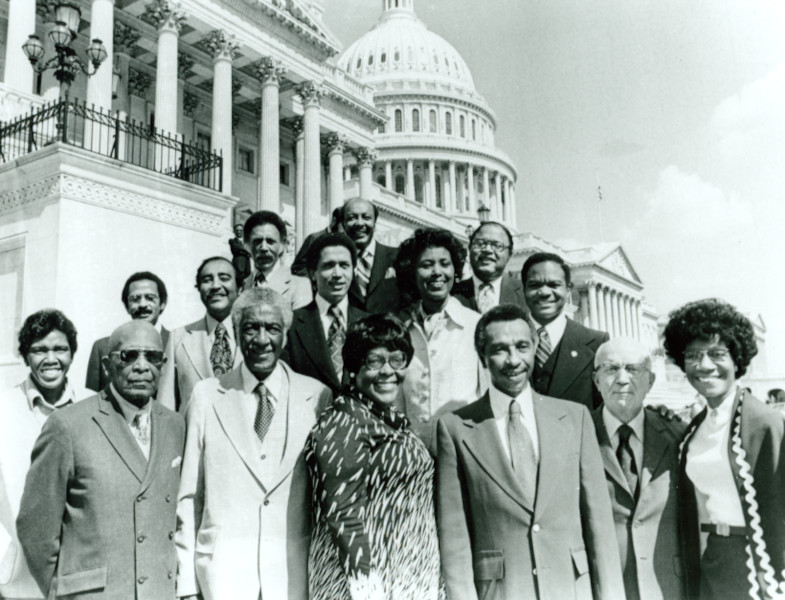Leadership
Chair: Joyce Beatty (OH–3)
2021–present
First vice-chair: Steven Horsford (NV-4, D)
Second vice-chair: Brenda Lawrence (MI-14, D)
Whip: Hank Johnson (GA-4, D)
Secretary: Frederica S. Wilson (FL-24, D)
Parliamentarian: Sheila Jackson-Lee (TX-18, D)
Member-at-large: Joe Neguse (CO-2, D)
As the number of African Americans serving in Congress grew, a long-desired movement to form a more unified organization among black legislators coalesced. When Charles C. Diggs Jr. of Michigan entered the House of Representatives in 1955, he joined black Members William Dawson of Illinois and Adam Clayton Powell of New York—the largest delegation of African Americans on Capitol Hill since Reconstruction.
After a few terms in the House, Diggs keenly felt the isolation endured by black Members due to their small numbers in Congress and, in some cases, an inability to connect on a personal level. Frustrated that black Representatives lacked a forum to discuss common concerns and issues, Diggs proposed the organization of the Democratic Select Committee (DSC) at the opening of the 91st Congress (1969–1971), maintaining that the DSC would fill a significant void by fostering the exchange of information among the nine African Americans then serving in Congress, as well as between black Representatives and House leadership.
Newly elected Members and beneficiaries of court-ordered redistricting, William (Bill) Clay Sr. of Missouri, Louis Stokes of Ohio, and Shirley Chisholm embraced the concept of a group for black legislators to “seize the moment, to fight for justice, to raise issues too long ignored and too little debated”—all of which quickly translated into a more influential association for African American Members.
Charles Rangel of New York thought of a new name for the group: the Congressional Black Caucus. The CBC elected Diggs as its first chairman.
“Black people have no permanent friends, no permanent enemies . . . just permanent interests,” William (Bill) Clay Sr. declared—a theme that set the tone for the CBC during its formative years and evolved into its motto.
Collection of Facts
The caucus is officially non-partisan; but, in practice, the vast majority of African Americans elected to Congress since the CBC's founding have been Democrats. Ten African American Republicans have been elected to Congress since the caucus was founded in 1971. Of these ten, only Evans, Franks, West, and Love joined the CBC.
Review a brief synopsis of Black Americans who have served in Congress. Joseph Rainey, William Dawson, and Gus Hawkins are a few of the African-American Members who made history in the House.
First Black American to serve in Congress
Hiram Revels of Mississippi began his service in the U.S. Senate when he was sworn in on February 25, 1870.
First African-American Representative elected to Congress
Joseph Rainey of South Carolina began his service in the House of Representatives when he was sworn in on December 12, 1870.
First African-American Representative to speak on the House Floor
Jefferson Long of Georgia spoke on the House Floor in 1871.
First African-American Representative to preside over a House session
Joseph Rainey of South Carolina presided over the House in 1874.
First African American to chair a congressional committee
Blanche Bruce of Mississippi became chairman of Senate Select Committee on the Mississippi River in 1877.
First African American to chair a standing congressional committee
William Dawson of Illinois became chairman of the Expenditures in the Executive Departments Committee (later named Government Operations) in 1949.
First African American popularly elected to the Senate
Edward Brooke of Massachusetts was elected to the Senate in 1966.
First Black-American woman elected to Congress
Shirley Chisholm of New York was elected to the House of Representatives in 1968.
First Black-American woman elected to the Senate
Carol Moseley-Braun of Illinois was elected to the Senate in 1992.
Cardiss Collins, Yvonne Brathwaite Burke, and Shirley ChisholmView Larger
Image courtesy of Moorland–Spingarn Research Center, Howard University More women joined the first black Congresswoman, Shirley Chisholm of New York, on Capitol Hill during this period. Pictured from left to right are: Cardiss Collins of Illinois, Yvonne Brathwaite Burke of California, and Chisholm. In the 110th Congress (2007–2009), women account for one-third of the total number of African-American Members.
First African-American Member whose child succeeded him in Congress
Harold Ford, Sr.’s son Harold Ford, Jr. was elected to his father’s Memphis, Tennessee, seat upon his retirement in 1996.
Most committees chaired by an African-American Member of Congress
Gus Hawkins of California holds the distinction of the most committees chaired by an African-American Member (four).
Longest congressional tenure for a black Member of Congress
Elected to the House in 1964, John Conyers of Michigan has the longest congressional tenure for a black Member of Congress.
State with the most African-American Members of Congress
Historically, Illinois has had the most African-American Members of Congress.
Teaching Tips
Ask students to locate three Weekly Historical Highlights dates that focus on Black Americans who served in Congress. Use Black Americans in Congress to research more about each of these Members.
Begin a class discussion with Representative Gus Hawkins’s quote, “The leadership belongs not to the loudest, not to those who beat the drums or blow the trumpets, but to those who day in and day out, in all seasons, work for the practical realization of a better world—those who have the stamina to persist and remain dedicated.” Ask students to think about the meaning of the quote, the possible context, and how the statement may have been related to the experience of the early African-American Members who served in Congress. Have students compile a list of traits they believe a leader should possess and start a class discussion about the different types of leaders.
Ask students to choose one former African-American Member of Congress. Have students create a list of biographical and legislative information about this Member, as well as any other distinctive or unique aspects to his/her career. Organize a mock press conference in which each person answers questions about his/her Member and shares important highlights with the rest of the class.
Creation and Evolution of the Congressional Black Caucus


